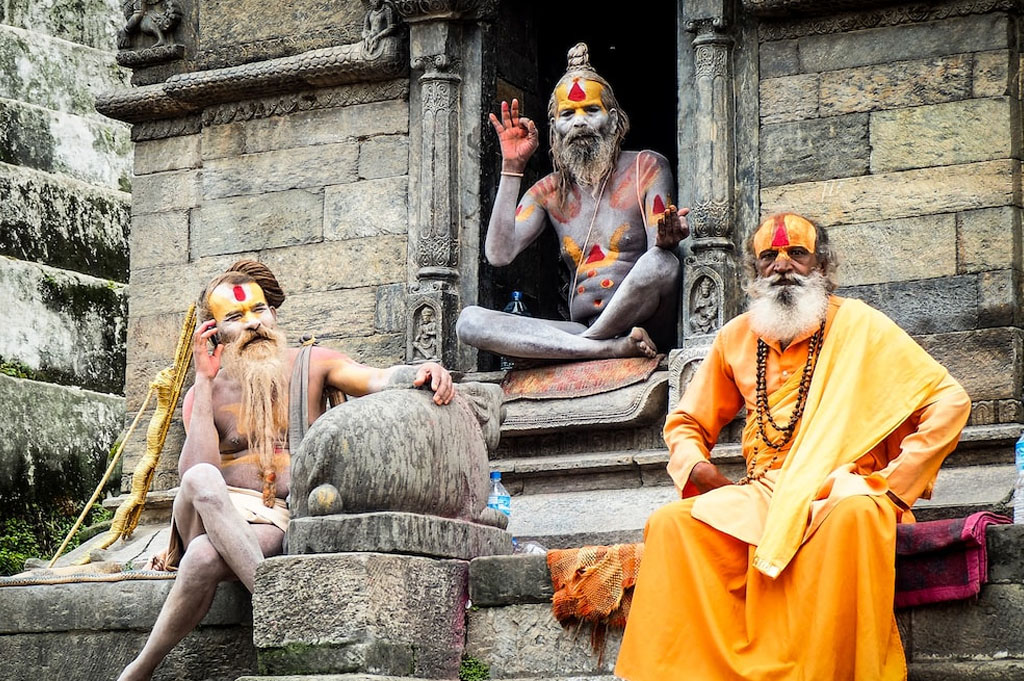On the banks of the Bagmati River, just beyond the eastern edge of Kathmandu, lies a sacred complex that has drawn seekers, sages, kings, and the dying for over 1,500 years — the Pashupatinath Temple.
Dedicated to Pashupati, an ancient and profound form of Lord Shiva as the “Lord of All Beings” (Pashu-pati), this temple is not merely a place of worship. It is a living continuum of Hindu spirituality, a UNESCO World Heritage Site, and one of the most important Shaivite pilgrimage centers in the world.
Unlike many temples that rose to prominence through royal patronage or mythic legend, Pashupatinath has always stood at the center — of ritual life, funerary rites, philosophical discourse, and trans-Himalayan religious exchange.
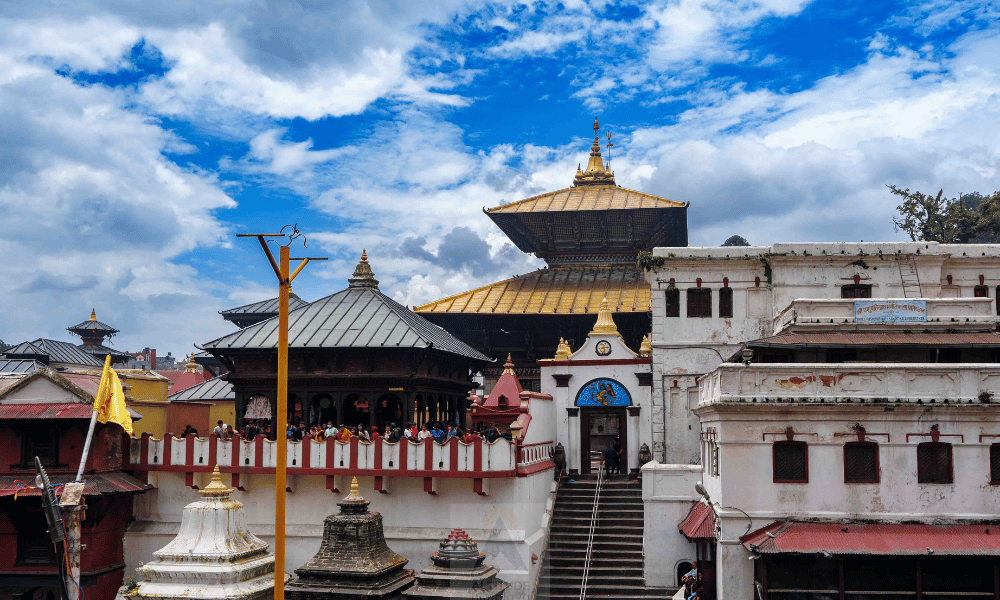
Location and Geography: The Sacred Axis of the Kathmandu Valley
Where is Pashupatinath?
- Location: Gaushala, Kathmandu District, Nepal
- Coordinates: 27.6906° N, 85.3227° E
- Elevation: ~1,330 meters (4,360 ft)
- River: Bagmati River, considered a manifestation of the Ganga in its purifying role
- Area: ~2.3 square kilometers (including temple complex, ghats, ashrams, and subsidiary shrines)
(Source: Survey of Nepal; UNESCO World Heritage List, 1979)
The temple lies on the east bank of the Bagmati, approximately 5 kilometers northeast of Kathmandu’s city center. The site is part of a larger sacred geography of the Kathmandu Valley, which includes:
- Swayambhunath Stupa (west)
- Baudhanath Stupa (northeast)
- Changu Narayan Temple (east)
Together, these four sites form the “Four Sacred Directions” in the valley’s spiritual cosmology, each representing a cardinal axis of dharma, liberation, and divine presence.

Historical Significance: From Earliest Inscriptions to Royal Patronage
The 5th-Century CE Inscription: The First Verifiable Record
The oldest confirmed historical evidence of Pashupatinath comes from a stone inscription discovered in 1997 near the northern entrance of the complex.
- Dated to 469 CE (reign of Licchavi King Jayadeva I)
- Written in Sanskrit, using Gupta script
- Mentions a golden chhatri (umbrella) donated to the temple
- Refers to the deity as “Śrī Pashupatinatha”
- Found embedded in a wall near the Rudra Vedi
This inscription, now preserved in the National Museum, Chhauni, Kathmandu, confirms that:
Pashupatinath was already a major Shaivite center by the 5th century CE, with structured worship, ritual fire altars, and royal patronage.

It is not a mythological claim — it is material proof of institutionalized Shaivism in Nepal over 1,500 years ago.
(Source: Inscriptions of the Licchavi Period, Department of Archaeology, Nepal, 2003)
Chinese Traveler Xuanzang: A 7th-Century Eyewitness Account
In 644 CE, the Chinese Buddhist monk and traveler Xuanzang (Hsüan-tsang) visited the Kathmandu Valley.
In his Great Tang Records on the Western Regions, he describes:
“A temple of great sanctity, dedicated to Mahadeva, stands on the banks of a river. It is revered by all, and many come here to perform rites.”
While he does not name “Pashupatinath” explicitly, scholars such as Dhanavajra Vajracharya and John K. Locke have confirmed that the description matches the location, river, and deity of Pashupatinath.
This is the first foreign eyewitness account of the temple, placing it firmly within the trans-Himalayan religious network of the 7th century.
(Source: The Life of Hiuen-Tsiang by Samuel Beal; Nepal: A Historical Study by John K. Locke)
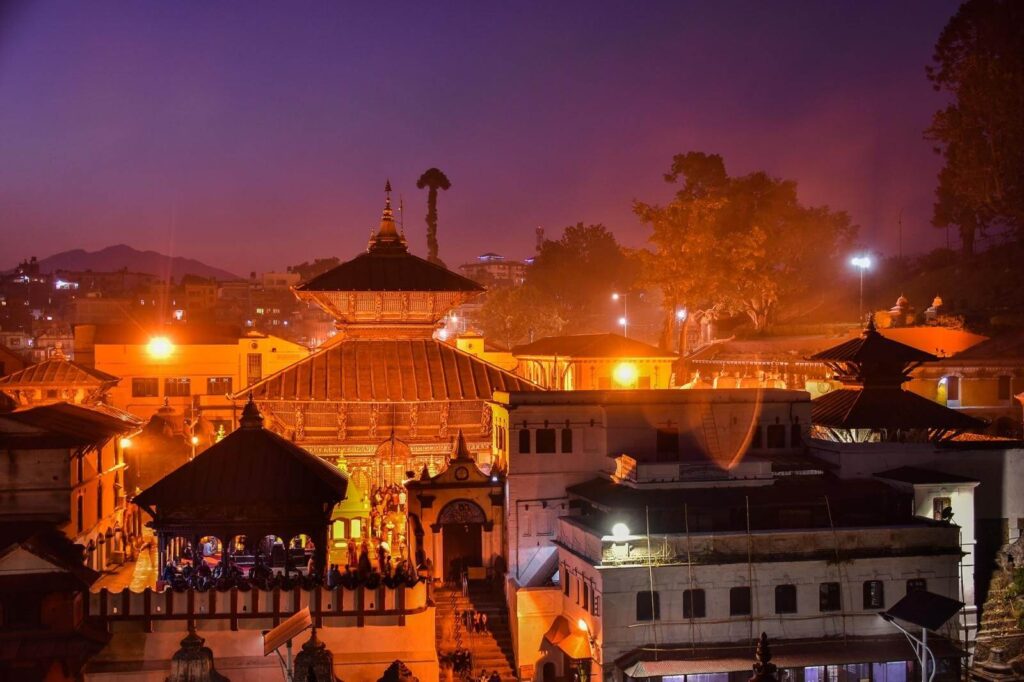
The Malla Period: Architectural Flourishing (1200–1769 CE)
The Licchavi period (c. 400–750 CE) laid the foundation, but it was during the Malla dynasty that Pashupatinath evolved into its current architectural and ritual form.
- King Jayasthiti Malla (1382–1395): Codified Hindu law and temple rituals in Nepal.
- King Pratap Malla (1641–1674): Commissioned inscriptions, ghats, and subsidiary shrines.
- King Bhupatindra Malla of Bhaktapur (1696–1722): Oversaw the reconstruction of the main temple after a major earthquake.
The current two-tiered pagoda structure was completed in 1702 CE, funded by Malla kings and Rana nobles, using gilded copper, stone carvings, and traditional timber joinery.
Crucially, there is no credible historical evidence that the temple was destroyed by any Muslim invader, including Bakhtiyar Khilji.
Debunking the Myth: Bakhtiyar Khilji and Pashupatinath
A persistent but unverified claim — found in some travel blogs, online forums, and even outdated guidebooks — is that Bakhtiyar Khilji destroyed Pashupatinath in the 13th century.
This is historically false.
Why This Claim Is Incorrect:
- No Contemporary Record:
- The Taj-ul-Ma’asir by Minhaj-i-Siraj, the primary Persian source on Khilji, mentions his invasion of Bihar and Bengal (c. 1200–1206), including the destruction of Vikramashila and Nalanda.
- No mention of Nepal or Pashupatinath.
- Geographical Impossibility:
- Khilji’s campaigns reached Bihar, near Bodh Gaya.
- He never entered Nepal. The Himalayan terrain, local resistance, and lack of strategic interest prevented deep incursions.
- No Archaeological Evidence:
- The Department of Archaeology, Nepal, has found no structural layer indicating destruction in the 13th century.
- Continuous epigraphic and ritual evidence shows unbroken worship at Pashupatinath.
- Temple Trust Records:
- The Pashupati Area Development Trust (PADT) maintains chronicles of temple repairs, none of which cite destruction by foreign invaders.

Conclusion:
The claim that Bakhtiyar Khilji destroyed Pashupatinath is a myth with no basis in historical, archaeological, or textual evidence. It likely arose from confusion with the destruction of Buddhist centers in Bihar, later misapplied to Pashupatinath.
(Source: The Delhi Sultanate by Peter Jackson; History of Nepal by D.R. Regmi; PADT Archives)
Temple Architecture: A Masterpiece of Nepali Pagoda Style
The main temple of Pashupatinath is a two-tiered golden pagoda, one of the finest examples of Newari temple architecture.
Key Structural Elements
| Roof | Two-tieredtriple-roofed pagodacovered withgilded copper tiles |
| Shikhar | Gilded golden pinnacle with statues of Shiva and Parvati |
| Doors | Four silver doors (east, west, north, south), each withrepoussé carvings of Nandi, makaras, and kirtimukhas |
| Garbhagriha | Houses the main lingam—a1-meter tall stone lingam with four faces (chaturmukha) representing Sadashiva |
| Mandapas | Main hall,Rudra Vedi(fire altar),Nandi Mandapa |
(Source: Department of Archaeology, Nepal; UNESCO Nomination File, 1978)
The Four-Faced Lingam
- Known as Chaturmukha Lingam or Arunachala Lingam
- Faces represent:
- East: Sadyojata (creation)
- South: Vamadeva (preservation)
- West: Aghora (transformation)
- North: Tatpurusha (introspection)
- The fifth aspect, Ishana (liberation), is implied upward.
Only priests (Bhandaris) are allowed to see and touch the lingam. No photographs are permitted inside the sanctum.
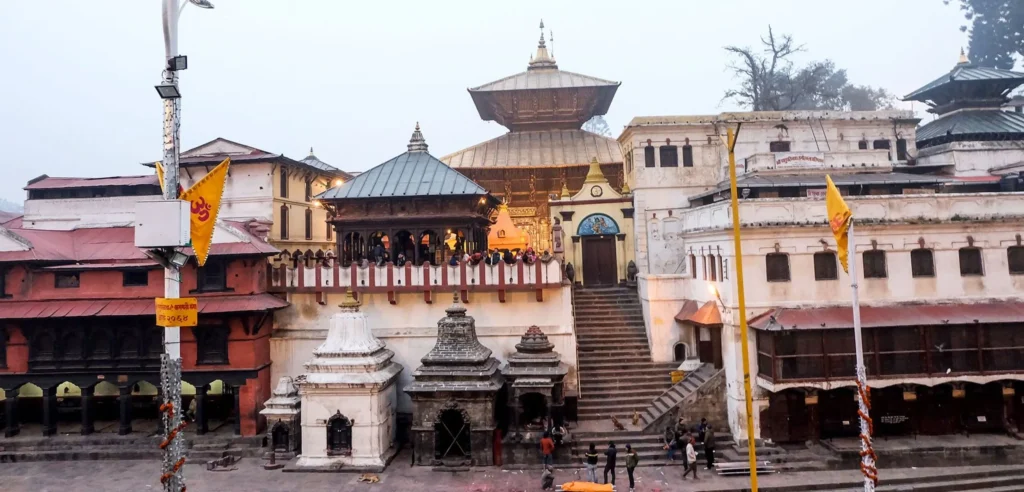
Religious Significance: The Lord of All Beings
Why “Pashupati”?
- Pashu = living beings (humans, animals, spirits)
- Pati = lord, protector
- Thus, Pashupati = “Lord of All Beings”
This reflects Shiva’s role as universal protector, not just a destroyer. The name appears in the Rigveda (Mandala 2, Hymn 33), where Rudra (proto-Shiva) is called “Pashupati”.
“O Rudra, Lord of cattle and all beings, protect us from harm.”
— Rigveda 2.33.9
(Source: The Rigveda: A Historical Analysis by Shrikant G. Talageri)
Moksha and the Arya Ghat
Pashupatinath is one of the few places in the world where cremation is considered essential for moksha.
- Arya Ghat (main cremation ghat) operates 24/7
- Over 500 bodies cremated annually (pre-pandemic)
- Rituals follow Vedic Antyeshti (last rites)
- Wood used: Sal logs, sourced sustainably
The belief is that dying near Pashupatinath ensures liberation from the cycle of rebirth.
(Source: Death and Afterlife in Hinduism by David Kinsley; Temple Trust Records)
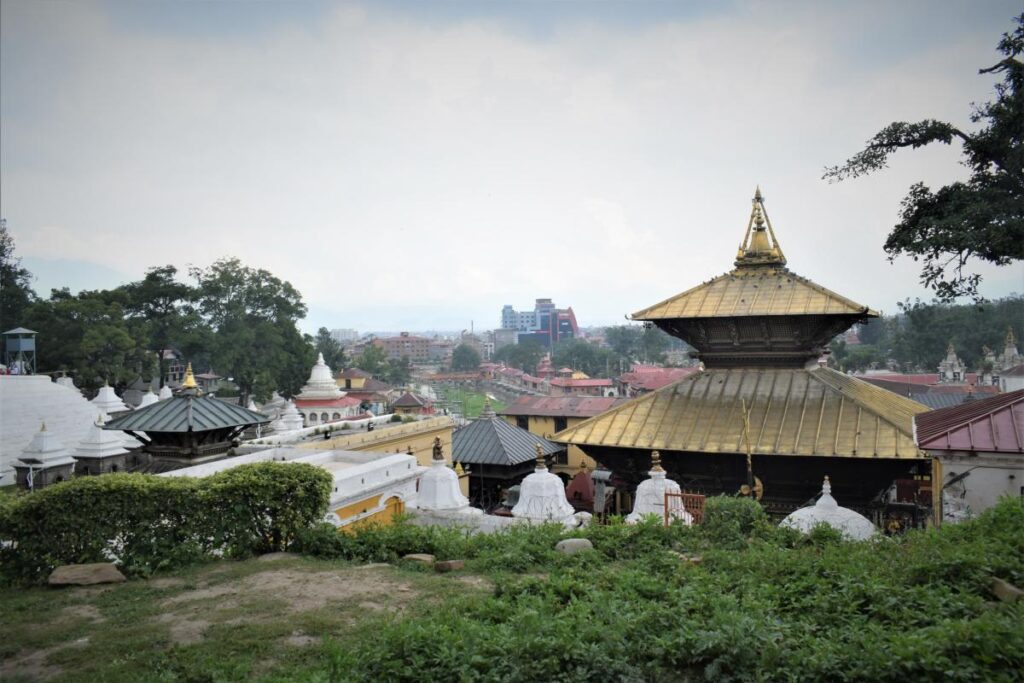
Rituals and Worship: A Continuous Cycle
Daily Puja Schedule
- Brahma Muhurta Aarti: 4:00 AM
- Morning Abhishekam: 6:00 AM (milk, honey, curd, ghee, water)
- Midday Aarti: 12:00 PM
- Evening Aarti: 6:00 PM
- Night Aarti: 9:00 PM
(Source: Pashupati Area Development Trust, 2023)
Priesthood: The Bhandaris
- Only four Bhandari families from Deoghar, Jharkhand (India) are allowed to perform darshan and abhishekam
- Lineage traced to Adi Shankaracharya, who appointed them in the 8th century CE
- Must remain celibate, pure, and ritual-bound
This tradition is still active, with priests trained from childhood.
(Source: The Pashupati Priests: A Study in Ritual Continuity – Journal of Hindu Studies, 2015)
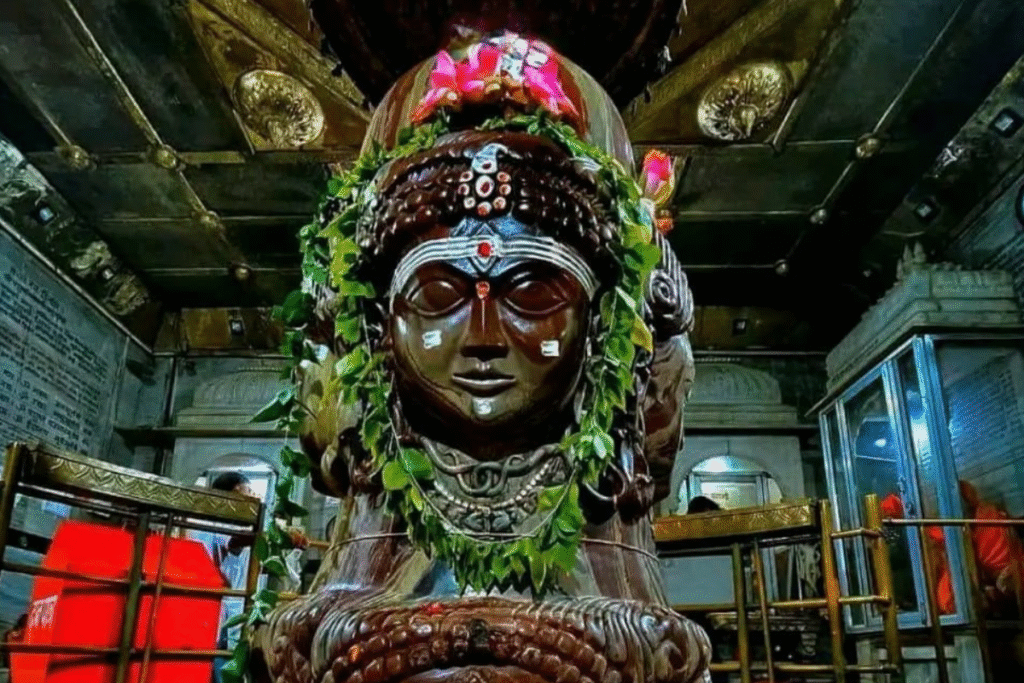
Festivals: When the Valley Comes to Pray
1. Maha Shivratri (February/March)
- Largest gathering: Over 1 million devotees
- Pilgrims from Nepal, India, and abroad
- Sadhus (ascetics) gather in Kedgiri and Guheshwari areas
- All-night jagran, bhajans, and abhishekam
- Government deploys 5,000+ security personnel
2. Teej (August/September)
- Women fast for marital longevity
- Sing teej geet and offer jala abhishekam
- Processions from Kathmandu
3. Bala Chaturdashi
- Families perform shraddha (ancestral rites)
- Offer pinda (rice balls) on ghats
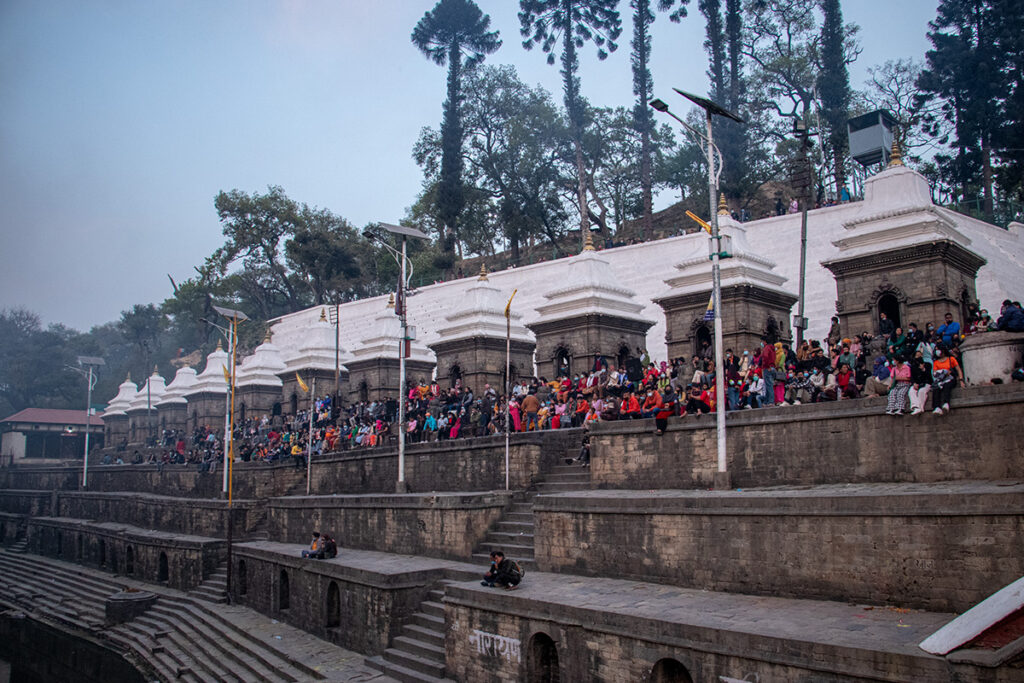
Ecology and Environmental Challenges
The Bagmati River: Sacred but Polluted
- Once pristine, now heavily polluted due to:
- Untreated sewage
- Industrial waste
- Plastic and ritual offerings
- DO (Dissolved Oxygen): <2 mg/L (critical level)
Conservation Efforts
- Bagmati Civilization Project (2013) – Government-led cleanup
- Pashupati Area Development Trust (PADT) – Daily river cleaning
- Ban on Plastic – Enforced since 2018
- Eco-friendly offerings promoted (flowers, rice)
Despite efforts, full restoration remains a challenge.
(Source: Nepal Tourism Board, Department of Water Resources, Nepal, 2022)
Cultural and Literary References
In Literature
- Mentioned in “The City of Joy” by Dominique Lapierre (1985) as a “sanctuary of fire and faith.”
- Referenced in “Sacred Waters” by Diana L. Eck as a “tirtha where life and death converge.”
In Media
- Featured in BBC’s “Himalaya” (2009)
- Covered by National Geographic, The Guardian, and Al Jazeera
Management and Preservation
Administrative Control
- Managed by Pashupati Area Development Trust (PADT)
- Chaired by Nepal’s Prime Minister
- Includes Hindu priests, archaeologists, and conservationists
UNESCO World Heritage Status
- Listed in 1979 under Cultural Criteria (iii), (iv), (vi)
- Criteria:
- (iii): Unique cultural tradition
- (iv): Outstanding example of Nepali temple architecture
- (vi): Direct association with beliefs of moksha
(Source: UNESCO World Heritage Centre, 1979)
Controversies and Challenges
1. Access Restrictions
- Only Hindus allowed inside the main temple
- Non-Hindus may view from opposite bank or upper terraces
- Based on religious sanctity, not discrimination
2. Commercialization
- Unauthorized shops, guesthouses
- Prostitution near ghats (illegal but persistent)
- PADT has removed over 200 illegal structures since 2015
Conclusion: The Eternal Flame of Shiva
Pashupatinath is not a temple of stone and gold. It is a living fire — on the ghats, in the hearts of devotees, in the chants of Om Namah Shivaya.
It stands where life ends and begins, where kings and beggars are equal in death, and where Shiva, as Pashupati, watches over all beings.
In an age of change, Pashupatinath remains unchanged — a sanctuary of eternal rhythm, sacred fire, and divine compassion.
And on the banks of the Bagmati, the flames never die.
FAQs on Pashupatinath Temple
1. Where is Pashupatinath Temple located?
It is situated on the banks of the Bagmati River, about 5 km northeast of Kathmandu, Nepal.
2. Who is worshipped at Pashupatinath Temple?
The temple is dedicated to Lord Shiva, worshipped here as Pashupati, the “Lord of All Beings.”
3. How old is the Pashupatinath Temple?
The earliest inscription dates to 469 CE, though legends trace the temple’s origins back over 2,000 years.
4. Why is Pashupatinath Temple famous?
It is one of the holiest Shiva shrines, a UNESCO World Heritage Site, and a major pilgrimage site for Hindus worldwide.
5. Can non-Hindus enter the temple?
Non-Hindus are not allowed inside the main sanctum but can explore the outer premises and ghats.
6. What is the significance of the Bagmati River here?
The Bagmati is considered sacred, and cremations performed on its banks are believed to lead to moksha (liberation).
7. What is the legend behind Pashupatinath Temple?
According to mythology, Lord Shiva took the form of a deer in the forest here, and the spot became sacred as Pashupatinath.
8. What festivals are celebrated at Pashupatinath?
Maha Shivaratri is the biggest festival, drawing thousands of sadhus and devotees from across India and Nepal.
9. Is Pashupatinath connected to Jyotirlingas?
Yes, it is regarded as one of the most important Shiva shrines outside India, spiritually linked with the 12 Jyotirlingas.
10. How can visitors reach Pashupatinath Temple?
It is a short drive from Tribhuvan International Airport, Kathmandu, easily accessible by road.

